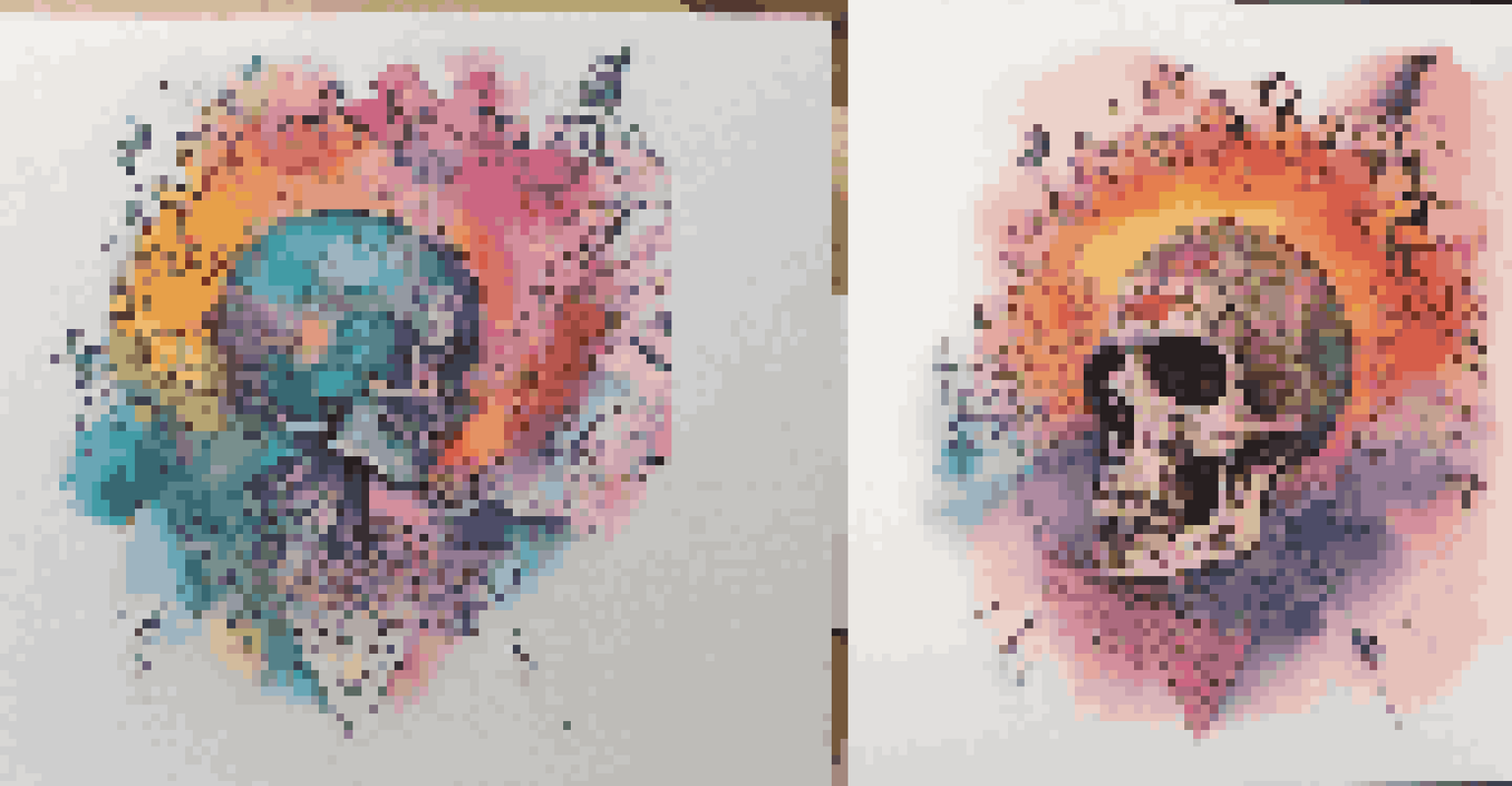The Art of Tattoo Stencils: Preparing for Perfect Ink

Understanding Tattoo Stencils and Their Importance
Tattoo stencils serve as a crucial blueprint for artists, helping them to capture the essence of a design before inking begins. They provide a clear outline, ensuring that the final piece aligns with the client's vision. Without stencils, the risk of misplacing intricate designs increases, leading to potential dissatisfaction.
A tattoo is a story that is written on the skin.
Think of a tattoo stencil as a roadmap for a long journey; it guides the artist, ensuring they stay on the right path. This not only helps in maintaining accuracy but also bolsters the confidence of both the tattooist and the client. When everyone is on board with the design, the tattooing process becomes a more enjoyable experience.
Additionally, stencils allow for experimentation with placement and sizing, which can be especially helpful in larger designs. By placing a stencil on the skin, artists can visualize how the tattoo will flow with the body’s contours, leading to a more harmonious final product.
Materials Needed for Creating Tattoo Stencils
Creating tattoo stencils involves a few basic materials that are essential for achieving the best results. You'll need stencil paper, which is specifically designed for the tattooing process, along with a thermal printer or a traditional hand-drawing tool. The choice between these methods often depends on the artist’s preference and the complexity of the design.

In addition to stencil paper, some artists also use transfer solutions to enhance the stencil's adherence to the skin. These solutions ensure that the stencil stays in place during the tattooing process, preventing smudging or movement. It's a small yet significant step that can make a big difference in the outcome of the tattoo.
Tattoo Stencils as Essential Tools
Tattoo stencils provide a clear blueprint for artists, ensuring the final design aligns with the client's vision.
Finally, having a clean workspace is crucial. This means having your tools organized and ensuring that everything is sanitized, which not only assures the artist's comfort but also prioritizes client safety. A tidy environment sets the stage for creativity and precision.
The Process of Creating a Tattoo Stencil
Creating a tattoo stencil can be a straightforward process when broken down into steps. It typically begins with designing the tattoo on paper or digitally, allowing for modifications before finalizing the artwork. Once the design is complete, it’s time to transfer it onto stencil paper, either through printing or by hand tracing.
The tattoo is a way of telling the world who you are without having to speak.
After the design is on stencil paper, the next step involves using a thermal copier if you're opting for that method. The copier makes an exact replica of the design onto the stencil paper, ensuring precision. For hand-drawn stencils, careful tracing is essential to maintain the integrity of the design.
Finally, once the stencil is prepared, it’s crucial to test it on a small area of the skin. This not only checks for alignment but also allows the artist to ensure that the stencil adheres correctly. If adjustments are needed, this is the perfect moment to make them before the tattooing process begins.
Best Practices for Applying Tattoo Stencils
Applying a tattoo stencil correctly is a skill that can greatly enhance the tattooing experience. First and foremost, ensure that the skin is clean and free from oils or lotions, as this will help the stencil adhere better. Using a stencil application solution can also be beneficial in achieving a smooth transfer.
When placing the stencil, it’s important to consider the flow of the body. This means aligning the design in a way that complements the natural curves and muscles of the area being tattooed. Taking a moment to step back and assess the placement can prevent any misalignments that could detract from the final piece.
Best Practices for Stencil Application
Proper skin preparation and alignment are crucial for a successful stencil application, enhancing the overall tattooing experience.
Lastly, always make sure to allow the stencil to dry completely before beginning the tattooing process. A fully set stencil will hold up better during the tattooing session, reducing the risk of smudging or fading as the needle works its magic.
Common Mistakes to Avoid with Tattoo Stencils
Even experienced tattoo artists can encounter pitfalls when it comes to using stencils. One of the most common mistakes is rushing through the creation and application process. Taking your time to ensure accuracy at each step can save you from headaches later on during the tattooing.
Another frequent issue arises from improper skin preparation. If the skin isn't cleaned properly, the stencil may not adhere well, leading to complications during the tattooing. Always prioritize skin hygiene to ensure a smooth application and better results.
Lastly, failing to check the stencil placement before starting can lead to misaligned tattoos. Always remember to double-check the positioning and even ask for the client's feedback. After all, communication is key in achieving that perfect ink.
The Role of Technology in Tattoo Stencil Creation
In today's digital age, technology has revolutionized the way tattoo stencils are created. Many artists now use software to design their tattoos, allowing for more intricate and detailed artwork. This digital approach not only enhances creativity but also streamlines the stencil creation process.
Thermal printers are another technological advancement that has transformed the tattoo stencil game. These devices can produce high-quality stencils quickly, reducing the time spent on manual replication. For busy tattoo shops, this efficiency can lead to increased productivity and more satisfied clients.
Technology's Impact on Stencils
Advancements in technology, like digital design software and thermal printers, have streamlined the tattoo stencil creation process.
However, while technology offers many advantages, traditional methods still hold value. Some artists prefer the tactile experience of hand-drawing stencils, as it allows for personal touch and intuition. Ultimately, the choice between technology and tradition comes down to personal preference and the desired outcome.
The Future of Tattoo Stencils in the Industry
As the tattooing industry continues to evolve, so too will the techniques surrounding tattoo stencils. Innovations in materials and technology are likely to lead to even more precise and adaptable stencil solutions. Artists may soon have access to new tools that enhance their ability to create stunning designs.
Moreover, as tattooing becomes more mainstream, there is a growing emphasis on training and education. This means that upcoming artists will likely learn best practices for stencil creation right from the start. The more knowledge they acquire, the better prepared they will be to create beautiful, lasting tattoos.

Finally, trends in tattooing often influence stencil techniques, with styles evolving alongside public interest. Whether it’s minimalistic designs or elaborate murals, the art of tattoo stencils will continue to adapt, ensuring that every tattoo tells a unique story.